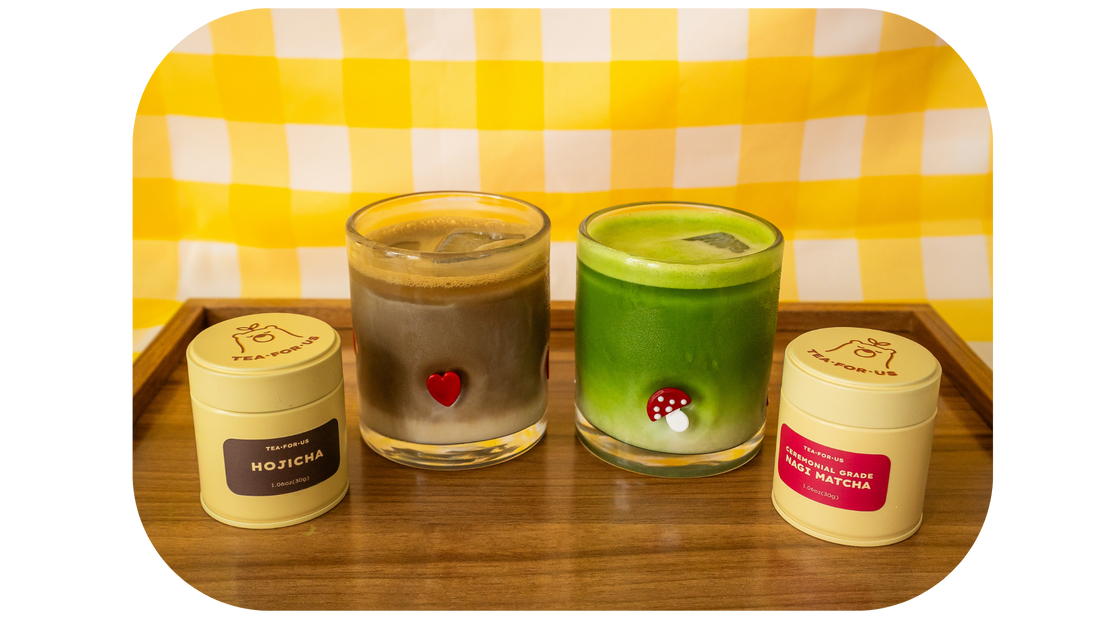
What’s the Difference Between Matcha and Hojicha?
In Japan, matcha and hojicha are special teas known for their health perks. They are grown differently, leading to distinct tastes and looks. Matcha is bright green, while hojicha has a roasted smell and brown color.
These teas are loved worldwide for their unique flavors and health benefits. Knowing the differences between matcha and hojicha helps us appreciate these teas more. It also tells us about their special benefits.
Key Takeaways
- Matcha and hojicha are two distinct types of Japanese tea with unique production methods.
- Matcha is known for its vibrant green color and rich, vegetative flavor.
- Hojicha is characterized by its roasted aroma and brownish hue.
- Both teas offer significant health benefits, from antioxidant properties to promoting relaxation.
- Understanding the differences can enhance your tea-drinking experience and offer insight into Japanese culture.
Origins and History of Japanese Green Teas
Japanese green teas are loved by many. Their history shows Japan's deep culture. It mixes old traditions with new tea ways.
Origins of Matcha

The japanese matcha origins go back to the Heian period (794-1185). It came from China and grew under Buddhist monks. They found that Tencha leaves, grown in shade, made a special tea.
Today, matcha is known for its bright green color and rich taste. It's a key part of japanese tea varieties.
Origins of Hojicha

Hojicha's story is newer, starting in the early 20th century. It was first made in Kyoto. Hojicha is made by roasting Sencha or Bancha leaves, giving it a sweet flavor.
This shows Japan's creativity in tea making. It's a new twist in japanese tea varieties.
Historical Significance
Matcha and hojicha are important in Japanese culture. Matcha is tied to Zen Buddhism, used in meditation and the daily tea ritual. Its careful making shows a deep connection to mindfulness.
Hojicha, with its warm taste, is a favorite for daily drinking. It shows how Japanese green teas are versatile. The green tea comparison between matcha and hojicha shows their unique histories and roles in Japanese life.
| Tea Variety | Origins | Leaves Used | Preparation |
|---|---|---|---|
| Matcha | Heian Period | Tencha | Ground into fine powder |
| Hojicha | Early 20th Century | Sencha or Bancha | Roasted |
Production Process and Appearance
Matcha and hojicha teas have unique qualities due to their production methods. Both come from green tea leaves but are prepared differently. This leads to distinct appearances and tastes.
How Matcha is Made
Matcha's creation is a detailed process. First, tea plants are shaded for three weeks. This increases chlorophyll, making matcha green.
Next, the leaves are handpicked and steamed to stop oxidation. This step keeps their color and nutrients. The leaves, now tencha, are dried and deveined.
Lastly, tencha is ground into a fine powder with stone mills. This makes matcha different from other green teas.

How Hojicha is Made
Hojicha's production is unique. It starts with green tea leaves, steamed to stop oxidation. Unlike matcha, these leaves are then roasted at high temperatures.
This roasting gives hojicha its smoky aroma and nutty flavor. After cooling, the leaves are ready for brewing into a warm drink.

Differences in Color and Texture
Matcha and hojicha look and feel different. Matcha is a fine, green powder from stone grinding. Hojicha, with its deep brown color, is a coarse, loose-leaf tea from roasting.
These production methods affect their appearance and taste. Each tea has its own unique flavor profile.
| Characteristic | Matcha | Hojicha |
|---|---|---|
| Color | Vibrant Green | Deep Brown |
| Texture | Fine Powder | Coarse Leaves |
| Flavor | Grassy, Sweet | Nutty, Smoky |
| Production | Shaded, Steamed, Stone-Ground | Roasted |
Matcha vs Hojicha

When we look at matcha vs coffee and hojicha vs coffee, we see two Japanese teas as great coffee alternatives. Matcha is packed with antioxidants, while hojicha has less caffeine, perfect for the evening. These traits are key when picking a focus drink or a tea for tea mindfulness.
- Matcha Benefits: This green tea is full of antioxidants, fighting free radicals in our bodies. It boosts mental clarity and alertness with its caffeine. Matcha's mix of caffeine and L-theanine gives energy without the coffee jitters.
- Hojicha Benefits: Hojicha is calming, thanks to its roasting process that lowers caffeine. It's great for relaxing in the evening or as part of a calming daily routine. The health benefits of hojicha include aiding digestion, improving heart health, and providing a soothing taste.
| Tea Type | Main Benefits | Best Time to Consume | Caffeine Content |
|---|---|---|---|
| Matcha | High antioxidants, enhances focus | Morning or afternoon | Moderate |
| Hojicha | Low caffeine, calming properties | Evening | Low |
Adding matcha or hojicha to your day can bring many benefits. Whether you need a morning pick-me-up or a calming evening drink, these teas are perfect. They support tea mindfulness and well-being, making them great coffee alternatives for a balanced life.
Flavor Profiles and Aroma
Exploring the taste and aroma of matcha and hojicha is a journey for tea lovers. We dive into the rich flavors of both teas. This helps us appreciate their unique qualities.
Taste and Aroma of Matcha
The taste and aroma of matcha are known for its vibrant green color. It has a complex profile, balancing sweetness with umami. This mix gives matcha a savory finish.
Matcha is loved for its rich flavors. It also boosts focus and energy. This makes it a favorite among many.

Taste and Aroma of Hojicha
The taste and aroma of hojicha stand out with its roasted taste. It has smoky and earthy notes, creating a sweet and comforting flavor. This makes it a great caffeine free tea.
Hojicha is also perfect as a bedtime tea. Its warm and soothing nature helps relax after a busy day.

Conclusion
As we wrap up our look at matcha vs hojicha, it's clear both have special qualities. Matcha is known for its bright green color and slightly bitter taste. It's made with care and is in a powdered form.
Hojicha, on the other hand, has a roasted, nutty flavor and a reddish-brown color. This comes from roasting green tea leaves in a traditional way.
Looking at health benefits, matcha is packed with antioxidants. These help detoxify and boost metabolism. It's a natural energy source without the coffee jitters.
Hojicha, with less caffeine, is great for unwinding. It aids digestion and promotes calmness, perfect for the evening.
In the end, it's not about picking one over the other. Matcha and hojicha each offer unique benefits. At Tea For US, we encourage you to try both. They can add richness to your daily life.
FAQ
What’s the difference between matcha and hojicha?
Matcha and hojicha differ in color, taste, and health perks. Matcha comes from Tencha leaves, with a bright green color and a mix of sweet and umami flavors. Hojicha, made from roasted sencha leaves, has a brown color and tastes smoky and sweet.


1 comment
This article was so detailed ! It was really helpful in learning the difference between hojicha and matcha, thank you !